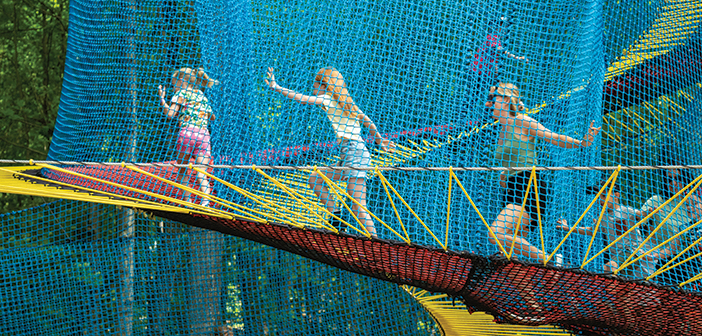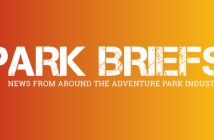In June, Quebec welcomed Upla, a new innovation in aerial adventure parks, built and operated by The Trekking Group. Located in the Montreal suburbs, Upla comprises a 2,000-square-meter (6,500+ square feet), multi-level universe of netted tunnels, treehouses, slides, ramps, games, mazes, and aerial forest walkways. Upla also features the largest outdoor trampoline structure in North America—with seven interconnected tramps, including one that’s two stories high.
The installation, says The Trekking Group CMO Jean-François Couture, is harmonious with nature, easy to maintain and operate, and fills a unique niche.
THE CONCEPT
For The Trekking Group, Upla is a return to its Canadian roots. The company, which turned 20 this year, is based in Quebec and now operates five parks there, with two more franchised out. In the last five years alone, The Trekking Group has built more than 70 different adventure parks and nature-based attractions around the world, from nearby Ontario to far flung destinations such as Macao and the Great Wall of China.
“Our specialty is to design, build, market, operate, and maintain aerial adventure construction in nature,” says Couture. “We don’t add concrete or build [digital]technology at our parks. We leave nature the way it is—as sustainable as possible.
“Upla gave us a chance to take that to the next level by combining the latest advances in netting and trampoline technology, and then bringing it to a setting that was completely harmonious with nature, one that would stimulate the imaginations of the visitors,” he says. “Best of all, it can stay open rain or shine, day or night, summer or winter.”
Connecting to the land. The land the park sits upon has a dark history—literally. “Upla was built in a place where, in 1998, there was a blackout. We call it the Black Triangle, because the affected area was shaped like a triangle,” says Couture, referring to the historic ice storm in January of that year that knocked out power to the entire region for about a month.
Couture recalls the time fondly, rather than regarding it as an inconvenience. Even back then, it was nice to disconnect from the traffic of the world. So, when it came time to pick a site for Upla, Couture felt there was no better homage than to build in the epicenter of the blackout region.
“It was a perfect fit for us, because we thought kids and even adults could find the same synchronicity. Finally, a place to put the cords and electronics aside,” he says.
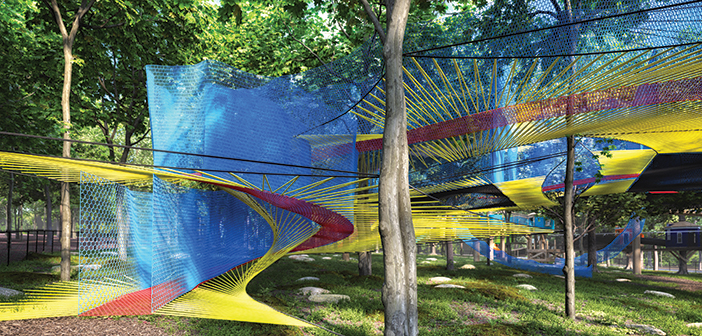
Netted ramps spiral to an at-height world of tunnels and trampolines at Upla in Quebec.

A two-story trampoline covers an area of 1,507 square feet and tops out at 35 feet above the ground.
THE NETTING
Upla’s infrastructure was created by The Trekking Group’s team of park designers and builders, who focused on developing an innovative design that was low maintenance and versatile.
“Quebec has hundreds of new attractions, and we needed to stand out with a unique product. Our entire concept of a world of trampolines and netting tunnels and aerial walkways made out of new, state-of-the-art materials is a first of its kind,” Couture says.
Custom nets. All of the park’s nets were custom designed and handmade in France by Chien Noir—or black dog, a trademark not easy to forget. Hailing from France’s Brittany region (Bretagne), Chien Noir traditionally makes netting for racing boats—catamarans and the like. The cutting-edge racing technology must be sturdy to survive open water and weather.
“Those nets are designed to save lives. That’s why we chose Chien Noir,” says Couture. (In addition to using it for Upla, The Trekking Group found the product so compelling that it also became the exclusive distributor of Chien Noir’s netting products in North America.)
Upla’s nets and tunnels are made of 8,327 square feet of galvanized stainless steel knitted netting, galvanized steel cables, woven netting of polypropylene, and polyester ropes—designed to be used in all climates and weather conditions. They are UV resistant, and shed rain, snow, and ice. When activated, small, foot-long “vibrators” (as Couture calls them) on each of the seven tramps drain ice, snow, and moisture off of the netting and structures. Originally introduced in Europe, the netting technology was brought to North America by The Trekking Group for its ease of operation and maintenance, even in winter.
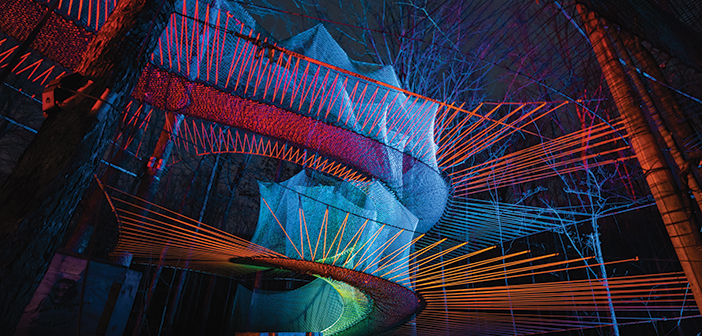
he park is open year-round, rain or shine, and day or night—with the assistance of lighting and other tech.

Former Cirque de Soleil employees designed Upla’s whimsical Treewalk Village.
THE BUILD
The centerpiece of the attraction is the largest trampoline structure in North America, according to Couture. A two-story outdoor trampoline—one stacked directly on top of the other—lies at the heart of the park, with an area of 1,507 square feet and 15 feet of vertical space above the first level. It has three entrances and exits, and three slides. The first story of the double-decker is 20 feet in the air, so the second story begins 35 feet off the ground.
“Our trampolines are made out of net—when you jump on them, it’s almost weightless. It’s like jumping on the moon,” says Couture.
Throughout the park, a labyrinth of suspension bridges connects seven brightly colored treehouses (“treetop maisonettes”), creating a suspended village. “Chill Zones”—places for anyone to relax, but mostly tired adults—are interspersed throughout.
Multi-functional space. “The Chill Zone is actually part of the upper trampoline and features many beanbag chairs for people to lay on and relax amid a 360-degree view of the forest from 35 feet in the air,” says Couture. “We hold our team brainstorming sessions up there, we find it so inspiring.”
The space has also received the attention of others who have imagined using it for a variety of different purposes. “Some companies have reached out to us to hold meetings in the two-story tramp by setting up a projector screen and bean-bag chairs,” Couture says. “DJs have also asked to do sets in midair as a stage—people on the floor dance while watching a midair DJ lit up in rainbow hues.”
For all guests, there are games to play inside the two-story trampoline, including dodgeball and volleyball.
The Treewalk Village portion of Upla was imagined and brought to life by staff who have a whimsical professional background. “It was employees of ours that used to work at Cirque de Soleil who designed the Treewalk Village for us,” says Couture. “The fellow who handled their tour logistics made sure our sets were assembled according to the plan and got where they needed to go on time. The other fellow did the actual design of all the set pieces—the maze of bridges and slides.”
Construction started at the beginning of summer 2021, and the build was completed on time and under budget, says Couture. “It only took a few weeks longer due to Covid, but we finished the Treewalk Village and netting in April without any supply-chain impacts or other complications.”
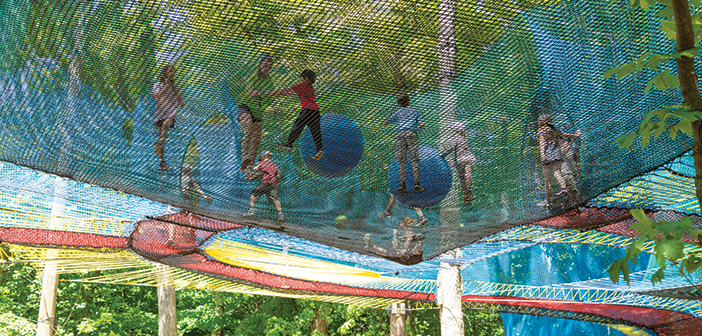
The park’s netted trampolines have multi-function potential as play space, meeting space, or party venue.
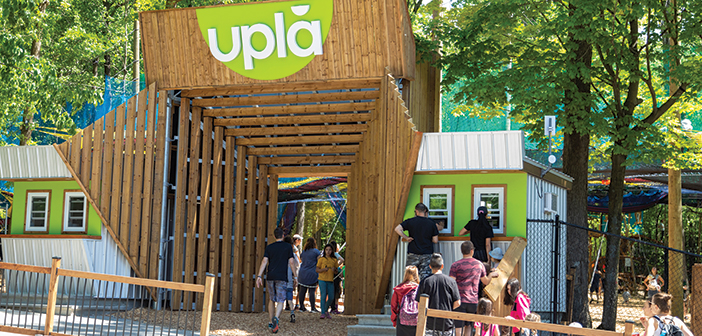
Upla welcomed 50,000 visitors in July.
THE BRANDING
To its creators, even the attraction’s name—“Upla”—is evocative.
“I invented the word while seeking a playful, meaningful, simple, and catchy brand name,” says Couture. “The first syllable—‘up’—relates to the aerial nature of this new adventure. It also alludes that you’re about take flight and start an exciting journey. The second syllable—‘là’—is a French word that means ‘there.’ It’s used to show someone where you’re going in the context of describing an action or location. ‘Hop-là’ is a French expression that means ‘come on’ or an imperative to get going.”
The Upla trademark joins The Trekking Group’s other Quebec-based properties under the umbrella brand name Arbraska, another invented moniker of Couture’s—a contraction of “arbre” (meaning “tree” in French) and “Alaska.” Made-up words, called “arbitrary marks,” have the strongest trademark protection and, therefore, the highest brand value, he notes.
THE RECEPTION
The hoopla for Upla was palpable from opening day, June 4. The park pre-sold 30,000 tickets before the opening and welcomed more than 50,000 visitors in July alone. Within two months, it had cleared CAN$1.5 million in revenue, Couture says, or about USD$1 million.
Why so popular? There are several million people within an hour’s drive, for one thing. And proximity to another busy Arbraska park, for another—just across the street is Arbraska Mont-Saint-Gregoire, a tree-based aerial course.
Couture says that many visitors combine a trip to Upla with a visit there, going from tramps and treehouses in the morning to the ropes course in the afternoon. The company plans to launch a combined ticket for the neighboring attractions in spring 2023.
Currently, a two-hour pass allows visitors to explore Upla for CAN$30 for ages 3-17 or CAN$20 for ages 18-64 (yes, it costs more for kids than adults); children under three are free, and adults 65+ get in free with a purchase of any ticket for another guest. Reservations are required for time slots that start every 30 minutes. Group reservations are also available, including for large special events and corporate team-building, which the park is promoting.
Couture notes that Upla has, so far, been able to run efficiently without needing huge numbers of staff tending to park features. “It’s easy to maintain. It’s netting, it drains,” he says.
At just a few months old, Upla has hit the ground running. The park was full all summer long after opening in June, and is working on adding event programming, such as a special light show on Oct. 15, that will be launched as a new added feature. As fall turns to winter, the park will remain open 365 days a year, with no plans to slow down. It has a lot to celebrate.


